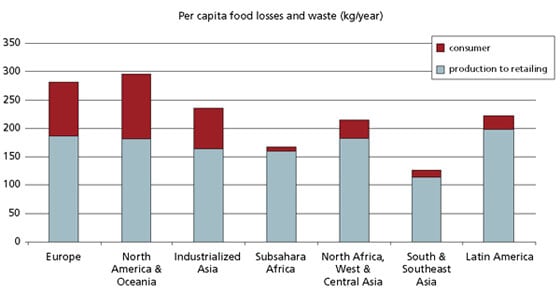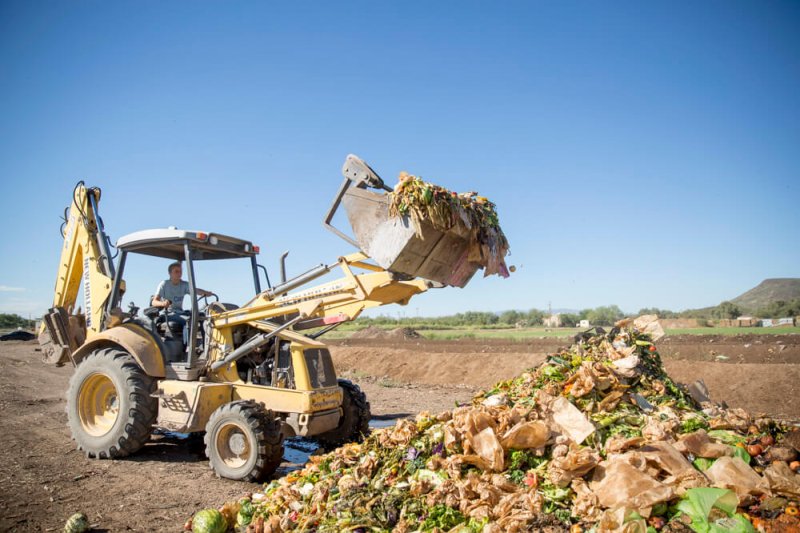How would you answer this?
Feeding a population that’s expected to exceed 9 billion by 2050, according to United Nation estimates, will require what?
The realistic answer: GMOs and reducing waste
Roughly one third of the food produced in the world for human consumption every year—approximately 1.3 billion tons—gets lost or wasted. Food waste amounts to roughly $680 billion in industrialized countries and $310 billion in developing countries.

Opponents of agricultural biotechnology say that improved yields and crop quality from engineered crop traits isn’t necessary. All the world needs to do is reduce the amount of food that’s wasted and we can feed our booming world population. Jonathan Foley, executive director of the California Academy of Sciences, wrote in The Macroscope that GMOs as a solution to food waste is a further financial waste:
Even cutting waste in half would be a huge step toward global food security and a boon for the environment. Billions of dollars are currently invested in genetic modification, advanced agricultural chemicals and farm machinery. Where is the comparable investment in reducing food waste?
Proponents of GMOs, however, point to studies questioning how much waste can realistically be reduced, and to new innovations that help food last longer and is easier to move off supermarket shelves. So what’s the story? Can GMOs help reduce food waste? Or is something else holding us back from being more efficient with our food?
Food waste is the loss of foods from market to consumer. This is largely an issue with wealthier countries, which overall have the processing, storage and transport facility to prevent what happens in poorer countries. In that part of the world, “food losses” result from spoilage, disease, or other diversions that occurs somewhere between the farm and the market. For medium- and high-income countries, about 40 percent of waste occur in the retail and consumption stages of food supply, while 40 percent of losses for low-income countries happen during post-harvest and processing.
Even though 10 percent of the total US energy budget, 50 percent of the land, and 80 percent of the freshwater consumed in this country is used to grow and deliver food to consumers, a third of all those resources are also wasted. The amount of food wasted or lost will vary a great deal by the type of food. For example, losses and waste worldwide come to about 30 percent for cereals, 40 to 50 percent for foot crops, fruits and vegetables, 20 percent for oil seeds, meat and dairy and 30 percent for fish.
Brenda Ellison from the University of Illinois and Jayson Lusk from Oklahoma State University wrote recently that people don’t waste food the same way, or for the same reasons. In their experiments, people presented with expired dates on milk would throw away the milk only if it smelled sour. Prices, amounts left in a carton, and the existence of a replacement carton had no impact. People responded quite differently, however, when confronted with a partially-consumed meal. In that case, the cost of the meal had the greatest influence on whether they’d save the food or toss it in the trash (the cheaper the food, the less likely that they’d toss it). What this shows, Lusk emphasized is that food waste is the product of rational thought (instead of random ignorance or forgetfulness), where people respond directly to time issues, and changes in prices.
According to Martine Rutten, an economist and food waste expert at the University of Wageningen in The Netherlands, this rational behavior can make controlling food waste more difficult. Losses and waste rise are heavily dependent on food prices, and measures to reduce wastes can affect prices for producers, which impacts their well-being. So, wasting less may not necessarily mean more available food.
“As a consequence,” Rutten writes, “the impacts, notably on food security and welfare, are ambiguous.”
This ambiguity means that when activist and author Robyn O’Brien writes in her blog post that:
The promise of these products [GMOs] to feed the world is not working here in the U.S. It’s tough to sell this when 45 million Americans go hungry and we throw away 40 percent of our food.
Then just taking that 40 percent, reducing it to nothing (or even 20 percent) and having it shipped to the developing world (or to hungry Americans) isn’t at all that clear-cut a solution. Economics studies have shown that while it’s nice to think we’d eat a spotty apple or still use food after its “best by” date, we probably won’t.
A number of less ambiguous genetic solutions have already shown promise in reducing wastes and losses. However, perhaps for the same reasons as food waste measures, their acceptance by consumers may still show some ambiguity. Some biotechnology solutions, which can introduce new food traits at just about any source of food waste, include:
- The Simplot potato was bred to use RNAi (small strips of RNA from the same, or a wild type potato that can halt or reduce gene expression) to regulate acrylamide levels, reducing browning and improve the quality of the spud’s starch. All of these traits would reduce the rejection of potatoes at market (either by a shop owner or a consumer), reducing the amount of food that, well, thrown away.
- The Arctic Apple, just approved this year, also uses RNAi to reduce browning (though it’s not from acrylamide like in potatoes). This also helps keep a lot more apples from the first-world waste bin, as more consumers would accept an apple without brown spots.
- Researchers at the University of Southampton, England, identified the genes that make lettuce leaves smaller, and closer together. These traits, it turned out, allow lettuce to stay fresher longer, both on the shop shelf and in a consumer refrigerator. While the researchers identified the genes, they used them to guide more traditional breeding methods.
- Other so-called “second generation” traits (unlike pest and pesticide resistance, or yield enhancements of the first) have also similarly focused on direct consumer benefits, including longer storage life, and resistance to post-harvest diseases and degradation.

Getting food to everyone who needs it still faces other challenges, such as political, infrastructure and distribution obstacles (and not just in the developing world). But as Gus Stahl wrote in Global Citizen last year, GMOs can be part of the picture of a world with less food waste:
By modifying crops to last longer in storage farmers can sell more of them and they can be kept longer, which, overall, results in more food for all–something we’re going to need even more in the near future.
Andrew Porterfield is a writer, editor and communications consultant for academic institutions, companies and nonprofits in the life sciences. He is based in Camarillo, California. Follow @AMPorterfield on Twitter.































